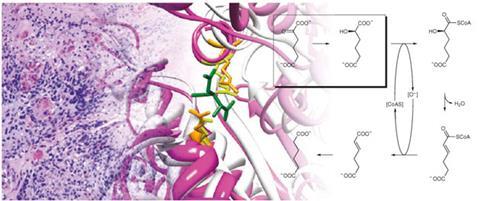
Cancer mutations have inspired a redesign of an enzyme to catalyse a key step in the bio-based production of adipic acid, a precursor to nylon. Currently, 5.5 million tonnes of nylon are manufactured worldwide every year for uses as diverse as clothing, carpets and toothbrush bristles.
Developing a clean, fully biological adipic acid synthesis would dramatically reduce costs and the need for fossil fuels or harsh solvents. As a result, industry is keen to use enzymes to catalyse chemical reactions to synthesise target molecules.
Cancers are notorious for having rogue enzymes, possessing mutations and catalysing alternative reactions to their healthy, wild type counterparts. Hai Yan’s team of cancer researchers at the Duke University Medical Center in North Carolina, US, looked to mutant enzymes to find new, industrially relevant biosynthetic pathways. They discovered an isocitrate dehydrogenase (IDH) enzyme that could catalyse the reaction of 2-oxoglutarate to (R)-2-hydroxyglutarate – a product with a five-carbon backbone that is just one carbon shorter than the adipic acid precursor (R)-2-hydroxyadipate.
The team used structural sequence homology to apply the same mutations found in the mutant IDH to homoisocitrate dehydrogenase (HIDH), which can catalyse reactions of six-carbon backbone structures. The new, redesigned HIDH enzyme can catalyse the reduction of 2-oxoadipate to the industrially useful (R)-2-hydroxyadipate. The HIDH mutant has high substrate specificity and excellent enantioselectivity delivering enantiomeric excesses of >99%. ‘This is exciting not only because we have a better understanding of these enzymes, but because we have an enzyme that has never been produced before and with a useful proposed function,’ says lead author Zach Reitman. ‘Hopefully, this is the last piece of the jigsaw puzzle for a promising fully biological route to adipic acid.’
Ian Mills, from the Centre for Molecular Medicine Norway (NCMM), says this study is an interesting illustration of translational cancer research. ‘Re-engineering enzymes expressed in primitive organisms, such as yeast or bacteria, to provide alternative routes to generate chemicals to sustain the manufacturing industry has the potential, if scaleable and efficient, to lessen the dependency on conventional catalysis and fossil fuels,’ Mills says. ‘Increased dialogue between cancer biologists and chemists will be critical to catalysing the rapid transfer of data from field-to-field and the timely exploration of new possibilities.’
Yan adds: ‘We are thrilled that a common gene mutation of a devastating disease can be harnessed for beneficial uses.’ The next steps will be to produce all of the enzymes required for this biological adipic acid route in the same microorganism, optimise the pathway and scale-up the process for industry.






No comments yet